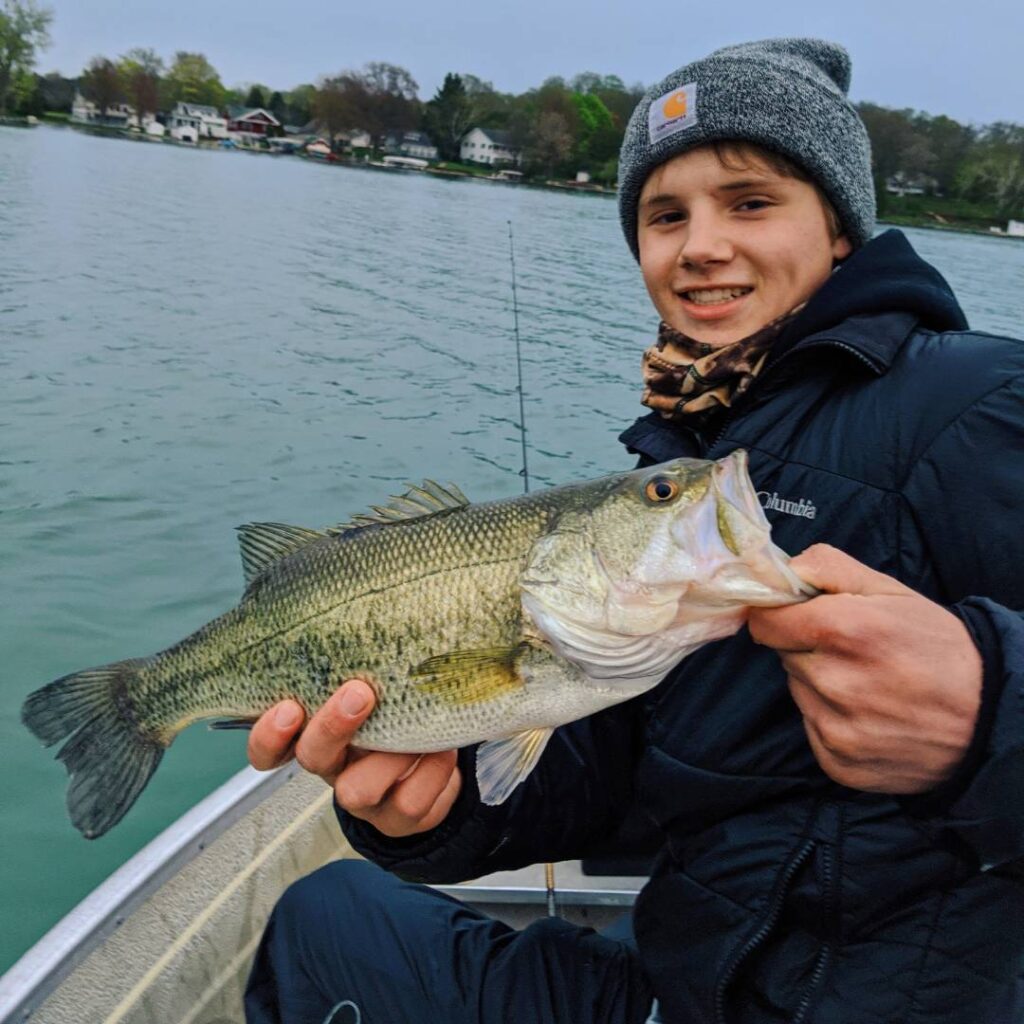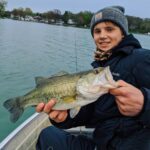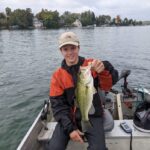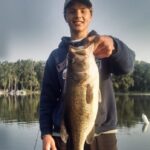Hey there anglers! If you are looking for a rig to target highly pressured and finicky fish, the drop shot is a great option. This rig is effective for both largemouth or smallmouth bass and can be tailored towards a variety of situations on the water. This finesse bass fishing technique is a game-changer. Whether you’re an experienced angler or just getting started in bass fishing, the drop shot rig is a critical technique to learn. Luckily you’re in the right place! This guide will provide you with everything you need to know about how to fish a drop shot rig for bass.
As always, fishing education and conservation are our priorities here at The Angler’s Line. Feel free to sign up for our free newsletter to join our community and stay up to date! Lets get started!
Table of Contents:
Rigging A Drop Shot
Drop shots are comprised of a hook and weight. The weight is tied to a tag end which is beneath the hook. The weight sits on the bottom and the hook is suspended up the line when fishing this rig.

Drop Shot Hooks
Drop shot hooks come in a variety of different shapes and sizes. Some drop shot hooks have built in swivels that allow you to tie off above and beneath the hook eye. Other drop shot hooks require a Palomar knot to create the tag end for the weight. Regardless of which style of hook you choose, you’ll want one with a light wire. Remember that this is a finesse technique that uses light line and equipment. Match the size of your hook to the size of soft plastic that you are using. A #2 size hook is generally a good starting point for most bass applications.
Drop Shot Weights
The three main styles of drop shot weights available are cylindrical, tear drop, and ball-shaped weights. Cylindrical drop shot weights are designed for fishing in vegetation. Meanwhile, ball-shaped weights are more geared towards fishing in rocks. Tear drop weights are a good all-around shape that will get the job done in most scenarios.
Besides shape, another difference between drop shot weights is the material. Drop shot weights are typically made from other lead or tungsten. Tungsten in much denser than lead which allows for a smaller profile and increased sensitivity. Additionally, tungsten in non-toxic. This comes at a slightly higher price compared to lead, so choose whichever makes the most sense for you.
As far as sizes go, anywhere from 1/8 oz to 3/8 oz is typical for bass. Choose the size of your drop shot weight based on the depth you are fishing as well as current and wind.
The Drop Shot Knot
In order to rig your drop shot correctly, you’ll need to learn the Palomar knot. Start by threading your line through the eye of the hook and double it back. Next tie a simple overhand knot, but don’t completely tighten it just yet. Slip the hook point back through the loop and pull the tag end through. Cinch it down, leaving a tag end of your desired length. This is where you’ll attach your weight.
Hooking Your Soft Plastic
The first way to rig a soft plastic on a drop shot is by running your hook into the bottom of the nose of the bait and out the top. This allows your bait to swing freely on the hook and keeps the hook exposed at all times. The other popular way of rigging a soft plastic on a drop shot is by running the hook through the bottom and towards the very front end of the bait while leaving it embedded. This prevents the lure from swinging freely on the hook and keeps the presentation weedless as well. The downsize to this rigging method is that you tend to go through more plastics. Choose whichever rigging method makes the most sense for your application.

Tag End Length
The tag end length is one of the most important, yet overlooked variables when it comes to drop shotting success. The key here is to pay attention to where the fish are positioned by using your electronics. For example, if you are noticing fish relating extremely close to bottom, shorten your tag end length to only a few inches. If the bass are up several feet, lengthen you tag end accordingly. Continually experiment and adjust the length until you find something that works. You’ll be surprised how much of a difference it can make.
Drop Shotting Gear
In order to effectively fish a drop shot rig for bass, you’ll benefit from having the right gear.
Rod
As far as rods go, everyone’s going to have a slightly difference preference. If one things for sure however, its that drop shotting requires a sensitive rod. In general, I recommend a light or medium-light power rod. For length, 6’6″ to 7′ is a good starting point. The slightly shorter length is ideal for drop shotting since lighter spinning rods tend to get whippy and less sensitive at longer lengths. Ultimately, choose what feels best to you.
Line
For drop shotting, I’ll either use braided line and a fluorocarbon leader or straight fluorocarbon line. The benefit of using braided line is that it does not have any stretch which makes it very sensitive. The downfall to braid is that it is much more visible to fish in the water, which is where the fluorocarbon leader comes into play. Some anglers prefer using braid and leader while other prefer straight fluorocarbon depending on personal preference. Either of these two lines will set you up for success. For braid, I recommend choosing between 10 to 20 lb test depending on the size of fish and type of cover you will be fishing. For fluorocarbon, choose between 6 to 12 lb test.
Soft Plastics
Now that you are rigged up, lets talk about what drop shot soft plastics to use. There are two many soft plastics to list in this guide, but the main two styles are worm imitators and baitfish imitators. The main thing to keep in mind is to match the hatch based on what the bass are feeding on primarily in your lake at a certain time of year.
Worms
Finesse worms and other small straight tail worms are very popular for drop shotting bass. Typically, these worms range anywhere from 4″ to 7″ in length. Choose a length depending on the size of fish you are targeting and what size forage they are feeding on. When fishing soft plastic worms on a drop shot, you’ll want to use the shaking retrieve.
Baitfish
Baitfish imitators are the other main style of soft plastic used for drop shots. Either use a straight tail minnow or paddle tail swimbait and choose the size depending on the size of forage in the lake. For straight tail minnows, don’t be afraid to get more aggressive and hop the bait off of bottom. For paddle tails, use more of a dragging retrieve to get the tail moving naturally.
When To Fish A Drop Shot
If you’re on the water an experience any of the following scenarios, consider tying on a drop shot.
Clear Water
Drop shots excel in clear water. This is a finesse fishing technique which relies heavily on bass seeing the bait. The drop shot doesn’t make much sound or vibration in the water, so the only way for bass to really notice it is through seeing it. If you do fish a drop shot in slightly stained water, opt for bold colors to make your presentation stand out.
Pressured Fish
Drop shots work well when fishing heavily pressured fish. Fish slowly and methodically with a drop shot and you can catch bass directly behind anglers after they already work through an area.
Snaggy Bottom
Fish drop shots when the bottom has snags since your hook is suspended up the line. For example. if there are weeds on the bottom that extend 1 foot up, use a tag end that is slightly longer to fish above them. Additionally, drop shots work well when fishing rocks or submerged timber for he same reason. For heavy cover applications, make sure to rig your soft plastic weedless.
How To Fish A Drop Shot
What you’ve all been waiting for, the different techniques to use for fishing the drop shot rig
Shake It In Place
One technique to fishing a drop shot is shaking it in place. Cast your rig out and let it reach bottom, then simply shake you line on semi-slack. Try not to move the weight when shaking it, only the soft plastic. After shaking it in place for awhile, reel in a few turns and repeat. Make sure to watch your line when fishing this way since most of your bites will occur when you are fishing on semi-slack line.
Drag It
Another popular way to fish a drop shot for bass is dragging it along the bottom. Simply cast your rig out and let it reach bottom, then retrieve it slowly along bottom with either your rod tip or by reeling slowly. Keep the weight along the bottom at all times. This retrieve works best when fishing with soft plastics that have movement at slow speeds such as paddle tail swimbaits or curly tail worms.
Hop It
Hopping a drop shot is often not talked about for bass fishing but works at well at certain times. Cast your rig out and let it reach bottom, then hop the weight several feet off bottom and let it fall. This is an aggressive way to fish a drop shot which most anglers don’t take advantage of. Most of your bites will occur right after the weight reaches bottom.
Vertically Jig
Vertically jigging a drop shot is popular among bass anglers, especially for smallmouth. The key to having success vertically jigging is using your electronics. Vertically jigging does not cover much water, so make sure to mark fish with your electronics before even wetting a line. Drop your drop shot down directly to the level of the fish and slowly jig it. This technique works when bass are relating to the bottom and also when bass are suspended.
There you have it – everything you need to know about how to fish a drop shot for bass. Remember to experiment with different types of soft plastics and vary your tag end length. Fish the drop shot in key areas where you know fish are holding and you’re bond to trick a few. So put your newfound knowledge to the test the next time you’re out on the water. Tight Lines!
More Bass Fishing Articles:






